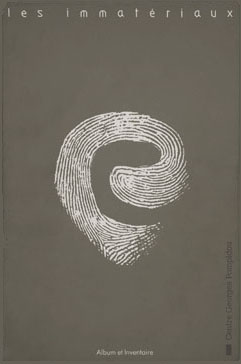Les Immatériaux: Épreuves d’écriture & Album et Inventaire (1985) [French]
Filed under catalogue | Tags: · architecture, art, cinema, code, computer art, design, industrial design, installation art, kinetic art, language, machine, painting, photography, robotics, sculpture, simulation, writing

“Les Immatériaux was a landmark exhibition co-curated in 1985 for the Centre Georges Pompidou in Paris by philosopher Jean-François Lyotard and design historian and theorist Thierry Chaput, attracting more than 200,000 visitors during the 15 weeks of its duration.
The exhibition brought together a striking variety of objects, ranging from the latest industrial robots and personal computers, to holograms, interactive sound installations, and 3D cinema, along with paintings, photographs and sculptures (the latter ranging from an Ancient Egyptian low-relief to works by Dan Graham, Joseph Kosuth and Giovanni Anselmo). The Centre de Création Industrielle (CCI) – the more ‘sociological’ entity devoted to architecture and design within the Centre Pompidou, which initiated Les Immatériaux – had been planning an exhibition on new industrial materials since at least 1982. Variously titled Création et matériaux nouveaux, Matériau et création, Matériaux nouveaux et création, and, in its last form, La Matière dans tous ses états, this exhibition, first scheduled to take place in 1984, already contained many of the innovative features that found their way into Les Immatériaux.
These features included an emphasis on language as matter, the immateriality of advanced technological materials (from textiles to plastics and holography), exhibits devoted to recent technological developments in food, architecture, music and video, and an experimental catalogue produced using computers. The earlier versions of the exhibition also involved many of the future protagonists of Les Immatériaux, such as Jean-Louis Boissier (among several other faculty members of Université Paris VIII, where Lyotard was teaching at the time) and Eve Ritscher (a London-based consultant on holography). Furthermore, Les Immatériaux benefited from projects pursued concurrently by other groups within the Pompidou which joined Lyotard’s and Chaput’s project when it was discovered that their themes overlapped. Thus, an exhibition project on music videos initiated by the Musée national d’art moderne and a project on electro-acoustic music developed by IRCAM (Institut de Recherche et de Coordination Acoustique/Musique) were incorporated into it.” (from a study by Anthony Hudek, 2009, edited)
Volume 1 contains an experimental glossary of 50 terms with contributions by twenty-six authors, writers, scientists, artists and philosophers including Nanni Balestrini, Michel Butor, François Châtelet, Jacques Derrida, Bruno Latour and Isabelle Stengers. Volume 2 reproduces the works exhibited.
Publisher Centre Georges Pompidou, Paris, March 1985
ISBN 2858502994 (I), 2858503001 (II)
263 (I) and 142 (nonpaginated A4) pages (II)
Épreuves d’écriture (Volume 1, 11 MB, added on 2014-7-30 via Norkhat)
Album et Inventaire (Volume 2, 103 MB, via Arts des nouveaux médias blog of Jean-Louis Boissier)
See also other documents and literature about the exhibition (Monoskop wiki).
Hillel Schwartz: The Culture of the Copy: Striking Likenesses, Unreasonable Facsimiles, 2nd ed. (1996/2013)
Filed under book | Tags: · animal, appropriation, art, children, computing, copy, death, fashion, film, gender, genetics, history, imitation, japan, language, machine, memory, music, photography, piracy, property, reenactment, reproduction, sculpture, simulation, slavery, statistics, surgery, technology, theatre, time, war

The Culture of the Copy is an unprecedented attempt to make sense of the Western fascination with replicas, duplicates, and twins. In a work that is breathtaking in its synthetic and critical achievements, Hillel Schwartz charts the repercussions of our entanglement with copies of all kinds, whose presence alternately sustains and overwhelms us. Through intriguing, and at times humorous, historical analysis and case studies in contemporary culture, Schwartz investigates a stunning array of simulacra—counterfeits, decoys, mannequins, and portraits; ditto marks, genetic cloning, war games, and camouflage; instant replays, digital imaging, parrots, and photocopies; wax museums, apes, and art forgeries, not to mention the very notion of the Real McCoy. Working through a range of theories on biological, mechanical, and electronic reproduction, Schwartz questions the modern esteem for authenticity and uniqueness. The Culture of the Copy shows how the ethical dilemmas central to so many fields of endeavor have become inseparable from our pursuit of copies—of the natural world, of our own creations, indeed of our very selves.
This updated edition takes notice of recent shifts in thought with regard to such issues as biological cloning, conjoined twins, copyright, digital reproduction, and multiple personality disorder. At once abbreviated and refined, it will be of interest to anyone concerned with proglems of authenticity, identity, and originality.
First published in 1996
Publisher Zone Books, New York, 2013
ISBN 1935408453, 9781935408451
480 pages
Review (Terence Hawkes, London Review of Books, 1997)
Review (Francis Kane, The New York Times, 1997)
Review (Todd Gitlin, Los Angeles Times, 1997)
Download (removed on 2014-3-20 upon request of the publisher)
Comment (1)Anne Burdick, Johanna Drucker, Peter Lunenfeld, Todd Presner, Jeffrey Schnapp: Digital_Humanities (2012)
Filed under book | Tags: · data mining, data visualisation, digital humanities, education, linguistics, simulation

“Digital_Humanities is a compact, game-changing report on the state of contemporary knowledge production. Answering the question, “What is digital humanities?,” it provides an in-depth examination of an emerging field. This collaboratively authored and visually compelling volume explores methodologies and techniques unfamiliar to traditional modes of humanistic inquiry–including geospatial analysis, data mining, corpus linguistics, visualization, and simulation–to show their relevance for contemporary culture.
Included are chapters on the basics, on emerging methods and genres, and on the social life of the digital humanities, along with “case studies,” “provocations,” and “advisories.” These persuasively crafted interventions offer a descriptive toolkit for anyone involved in the design, production, oversight, and review of digital projects. The authors argue that the digital humanities offers a revitalization of the liberal arts tradition in the electronically inflected, design-driven, multimedia language of the twenty-first century.
Written by five leading practitioner-theorists whose varied backgrounds embody the intellectual and creative diversity of the field, Digital_Humanities is a vision statement for the future, an invitation to engage, and a critical tool for understanding the shape of new scholarship.”
Publisher MIT Press, 2012
Open Access
ISBN 0262018470, 9780262018470
x+141 pages

